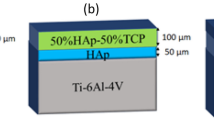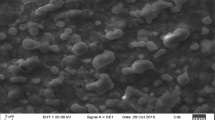Abstract
Bioactive ceramic coatings based on calcium phosphates yield better functionality in the human body for a variety of metallic implant devices including orthopaedic and dental prostheses. In the present study chemically and hence functionally gradient bioceramic coating was obtained by pulsed laser deposition method. Calcium phosphate bioactive ceramic coatings based on hydroxyapatite (HA) and tricalcium phosphate (TCP) were deposited over titanium substrate to produce gradation in physico-chemical characteristics and in vitro dissolution behaviour. Sintered targets of HA and α-TCP were deposited in a multi target laser deposition system. The obtained deposits were characterized by X-ray diffraction, fourier transform infrared spectroscopy, scanning electron microscopy and energy dispersive X-ray analysis. Inductively coupled plasma spectroscopy was used to estimate the in vitro dissolution behaviour of coatings. The variation in mechanical property of the gradient layer was evaluated through scratch test and micro-indentation hardness. The bioactivity was examined in vitro with respect to the ability of HA layer to form on the surface as a result of contact with simulated body fluid. It could be inferred that chemically gradient functional bioceramic coating can be produced by laser deposition of multiple sintered targets with variable chemical composition.











Similar content being viewed by others
References
Niinomi M. Recent research and development in titanium alloys for biomedical applications and healthcare goods. Sci Technol Adv Mater. 2003;4:445–54.
Ratner BD. A perspective on titanium biocompatibility. In: Brunette DM, Tengvall P, Textor M, Thomsen P, editors. Titanium in medicine. Berlin: Springer; 2001. p. 1–12.
Bannon BP, Mild EE. Titanium alloys for biomaterial application: an overview, titanium alloys in surgical implants. ASTM STP. 1983;796:7–15.
Hench Ll. Bioceramics: from concept to clinic. J Am Ceram Soc. 1991;74:1487–510.
Legeros RZ. Calcium phosphate materials in restorative dentistry: a review. Adv Dent Res. 1988;2(l):164–80.
Lind M, Overgaard S, Bunger C, Soballe K. Improved bone anchorage of hydroxyapatite coated implants compared with tricalcium-phosphate coated implants in trabecular bone in dogs. Biomaterials. 1999;20:803–8.
Kjeld S. Hydroxyapatite ceramic coating for bone implant fixation. Acta Orthop. 1993;64(1):1–58.
Baltag I, Watanabe K, Kusakari H, Taguchi N, Miyakawa O, Kobayashi M, Ito N. Long-term changes of hydroxyapatite-coated dental implants. J Biomed Mater Res B. 2000;53:76–85.
Narayanan R, Seshadri SK, Kwon TY, Kim KH. Calcium phosphate-based coatings on titanium and its alloys. J Biomed Mater Res B. 2008;85B:279–99.
Lacefield William R. Material characteristics of uncoated/ceramic-coated implant materials. Adv Dent Res. 1999;13:21–6.
MacDonald DE, Betts F, Stranick M, Doty S, Boskey AL. Physicochemical study of plasma-sprayed hydroxyapatite-coated implants in humans. J Biomed Mater Res. 2001;54:480–90.
Massaro C, Baker MA, Cosentino F, Ramires PA, Klose S, Milella E. Surface and biological evaluation of hydroxyapatite-based coatings on titanium deposited by different techniques. J Biomed Mater Res. 2001;58:651–7.
Yang Y, Kim K-H, Ong JL. A review on calcium phosphate coatings produced using a sputtering process—an alternative to plasma spraying. Biomaterials. 2005;26:327–37.
Wen J, Leng Y, Chen J, Zhang C. Chemical gradient in plasma-sprayed HA coatings. Biomaterials. 2000;21:1339–43.
Sun L, Berndt CC, Khor KA, Cheang HN, Gross KA. Surface characteristics and dissolution behavior of plasma-sprayed hydroxyapatite coating. J Biomed Mater Res. 2002;62:228–36.
Cleries L, Fernandez-Pradas JM, Morenza JL. Bone growth on and resorption of calcium phosphate coatings obtained by pulsed laser deposition. J Biomed Mater Res. 2000;49:43–52.
Zeng H, Lacefield WR. The study of surface transformation of pulsed laser deposited hydroxyapatite coatings. J Biomed Mater Res. 2000;50:239–47.
Zeng H, Lacefield WR. XPS, EDX and FTIR analysis of pulsed laser deposited calcium phosphate bioceramic coatings: the effects of various process parameters. Biomaterials. 2000;21:23–30.
Arias JL, Garcia-Sanz FJ, Mayor MB, Chiussi S, Pou J, Leon B, Perez-Amor M. Physicochemical properties of calcium phosphate produced by pulsed laser deposition at different water vapour pressures. Biomaterials. 1998;19:883–8.
Rajesh P, Muraleedharan CV, Komath M, Varma H. Laser surface modification of titanium substrate for pulsed laser deposition of highly adherent hydroxyapatite. J Mater Sci Mater Med. 2011;22:1671–9.
Kim H, Camata RP, Vohra YK, Lacefield WR. Control of phase composition in hydroxyapatite/tetracalcium phosphate biphasic thin coatings for biomedical applications. J Mater Sci Mater Med. 2005;16(10):961–6.
Jalota S, Bhaduri SB, Cuneyt Tas A. In vitro testing of calcium phosphate (HA, TCP, and biphasic HA–TCP) whiskers. J Biomed Mater Res. 2006;78A:481–90.
Aebli N, Krebs J, Schwenke D, Stich H, Schawalder P, Theis JC. Degradation of hydroxyapatite coating on a well-functioning femoral component. J Bone Joint Surg Br. 2003;85B:499–503.
Cleries L, Fernandez-Pradas JM, Sardin G, Morenza JL. Application of dissolution experiments to characterise the structure of pulsed laser-deposited calcium phosphate coatings. Biomaterials. 1999;20:1401–5.
Varma HK, Sivakumar R. Preparation and characterisation of free flowing hydroxyapatite powders. Phosphorous Res Bull. 1996;6:35–8.
ISO 20502:2005(E). Fine ceramics (advanced ceramics, advanced technical ceramics)—determination of adhesion of ceramic coatings by scratch testing. Geneva: International organization for standardization (ISO); 2005.
Standard test method for knoop and Vickers hardness of materials (Designation: E384-10e2). doi:10.1520/E0384-10E02.
Kokubo T, Takadama H. How useful is SBF in predicting in vivo bone bioactivity? Biomaterials. 2006;27:2907–15.
Rajesh P, Muraleedharan CV, Komath M, Varma H. Pulsed laser deposition of hydroxyapatite on titanium substrate with titania interlayer. J Mater Sci Mater Med. 2011;22:497–505.
Lu X, Leng Y. Theoretical analysis of calcium phosphate precipitation in simulated body fluid. Biomaterials. 2005;26:1097–108.
Bohner M, Lemaitre J. Leading opinion: can bioactivity be tested in vitro with SBF solution? Biomaterials. 2009;30:2175–9.
Cleries L, Fernandez-Pradas JM, Morenza JL. Behavior in simulated body fluid of calcium phosphate coatings obtained by laser ablation. Biomaterials. 2000;21:1861–5.
Rehman I, Bonfield W. Characterization of hydroxyapatite and carbonated apatite by photo acoustic FTIR spectroscopy. J Mater Sci Mater Med. 1997;8:1–4.
Acknowledgments
The authors gratefully acknowledge The Director and Head, Biomedical Technology Wing, SCTIMST for extending the research facilities to successfully carry out this work. Rajesh P acknowledges Kerala State Council for Science Technology and Environment (KSCSTE) for the research fellowship.
Author information
Authors and Affiliations
Corresponding author
Rights and permissions
About this article
Cite this article
Rajesh, P., Muraleedharan, C.V., Sureshbabu, S. et al. Preparation and analysis of chemically gradient functional bioceramic coating formed by pulsed laser deposition. J Mater Sci: Mater Med 23, 339–348 (2012). https://doi.org/10.1007/s10856-011-4501-6
Received:
Accepted:
Published:
Issue Date:
DOI: https://doi.org/10.1007/s10856-011-4501-6




